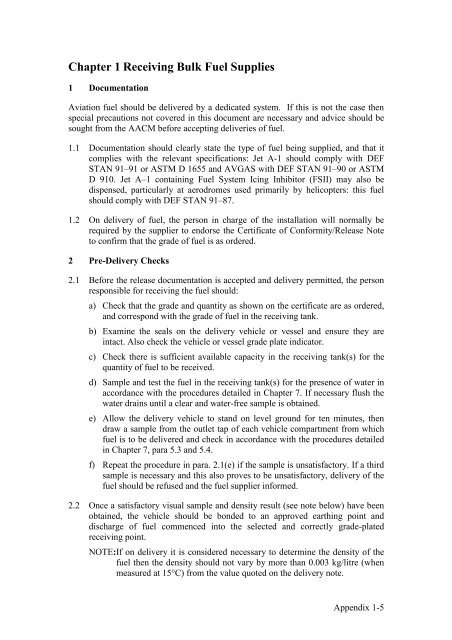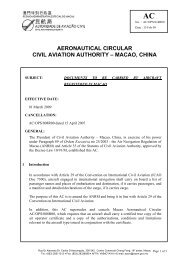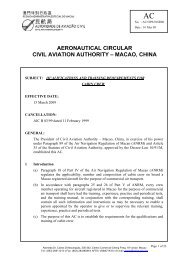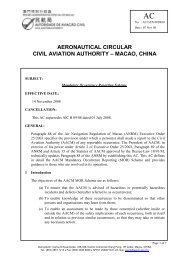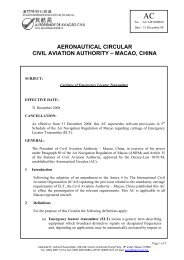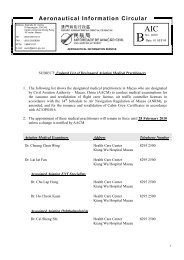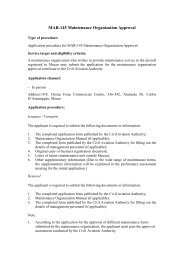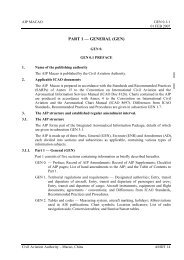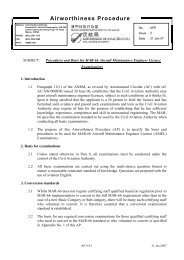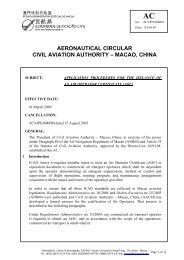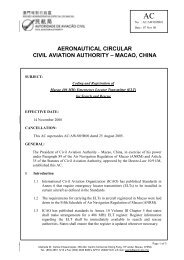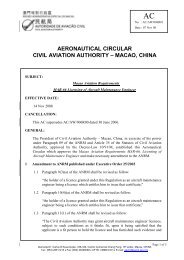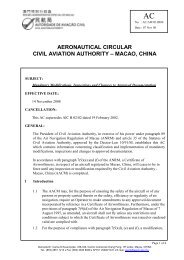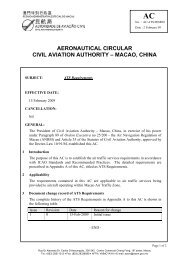Aviation Fuel at Aerodromes - Storage, Handling and Quality Control
Aviation Fuel at Aerodromes - Storage, Handling and Quality Control
Aviation Fuel at Aerodromes - Storage, Handling and Quality Control
You also want an ePaper? Increase the reach of your titles
YUMPU automatically turns print PDFs into web optimized ePapers that Google loves.
Chapter 1 Receiving Bulk <strong>Fuel</strong> Supplies<br />
1 Document<strong>at</strong>ion<br />
<strong>Avi<strong>at</strong>ion</strong> fuel should be delivered by a dedic<strong>at</strong>ed system. If this is not the case then<br />
special precautions not covered in this document are necessary <strong>and</strong> advice should be<br />
sought from the AACM before accepting deliveries of fuel.<br />
1.1 Document<strong>at</strong>ion should clearly st<strong>at</strong>e the type of fuel being supplied, <strong>and</strong> th<strong>at</strong> it<br />
complies with the relevant specific<strong>at</strong>ions: Jet A-1 should comply with DEF<br />
STAN 91–91 or ASTM D 1655 <strong>and</strong> AVGAS with DEF STAN 91–90 or ASTM<br />
D 910. Jet A–1 containing <strong>Fuel</strong> System Icing Inhibitor (FSII) may also be<br />
dispensed, particularly <strong>at</strong> aerodromes used primarily by helicopters: this fuel<br />
should comply with DEF STAN 91–87.<br />
1.2 On delivery of fuel, the person in charge of the install<strong>at</strong>ion will normally be<br />
required by the supplier to endorse the Certific<strong>at</strong>e of Conformity/Release Note<br />
to confirm th<strong>at</strong> the grade of fuel is as ordered.<br />
2 Pre-Delivery Checks<br />
2.1 Before the release document<strong>at</strong>ion is accepted <strong>and</strong> delivery permitted, the person<br />
responsible for receiving the fuel should:<br />
a) Check th<strong>at</strong> the grade <strong>and</strong> quantity as shown on the certific<strong>at</strong>e are as ordered,<br />
<strong>and</strong> correspond with the grade of fuel in the receiving tank.<br />
b) Examine the seals on the delivery vehicle or vessel <strong>and</strong> ensure they are<br />
intact. Also check the vehicle or vessel grade pl<strong>at</strong>e indic<strong>at</strong>or.<br />
c) Check there is sufficient available capacity in the receiving tank(s) for the<br />
quantity of fuel to be received.<br />
d) Sample <strong>and</strong> test the fuel in the receiving tank(s) for the presence of w<strong>at</strong>er in<br />
accordance with the procedures detailed in Chapter 7. If necessary flush the<br />
w<strong>at</strong>er drains until a clear <strong>and</strong> w<strong>at</strong>er-free sample is obtained.<br />
e) Allow the delivery vehicle to st<strong>and</strong> on level ground for ten minutes, then<br />
draw a sample from the outlet tap of each vehicle compartment from which<br />
fuel is to be delivered <strong>and</strong> check in accordance with the procedures detailed<br />
in Chapter 7, para 5.3 <strong>and</strong> 5.4.<br />
f) Repe<strong>at</strong> the procedure in para. 2.1(e) if the sample is uns<strong>at</strong>isfactory. If a third<br />
sample is necessary <strong>and</strong> this also proves to be uns<strong>at</strong>isfactory, delivery of the<br />
fuel should be refused <strong>and</strong> the fuel supplier informed.<br />
2.2 Once a s<strong>at</strong>isfactory visual sample <strong>and</strong> density result (see note below) have been<br />
obtained, the vehicle should be bonded to an approved earthing point <strong>and</strong><br />
discharge of fuel commenced into the selected <strong>and</strong> correctly grade-pl<strong>at</strong>ed<br />
receiving point.<br />
NOTE:If on delivery it is considered necessary to determine the density of the<br />
fuel then the density should not vary by more than 0.003 kg/litre (when<br />
measured <strong>at</strong> 15°C) from the value quoted on the delivery note.<br />
Appendix 1-5


